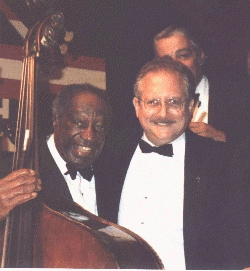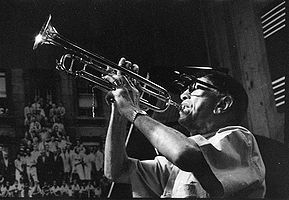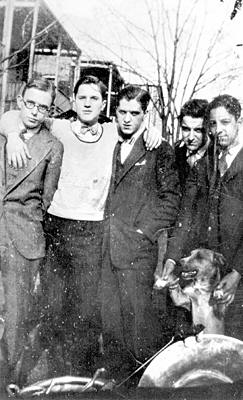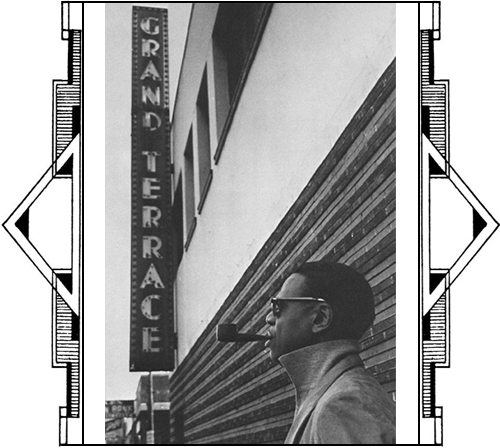.jpg)
Milt Hinton and Doc Cheatham, from book I Guess I'll Get The Papers and Go Home - The Life of Doc Cheatham by Adolphus 'Doc' Cheatham, with Alyn Shipton.
In the 1920s Chicago was the place to hear the hottest, new sounds as jazz and blues emerged on the popular music scene. On this edition of Riverwalk Jazz, celebrated jazzmen Doc Cheatham and Milt Hinton recall what it was like as young musicians coming of age on the early Chicago jazz scene.
Born in Mississippi in 1910 legendary bassist Milt Hinton, now widely recognized as the most recorded musician in 20th century jazz and popular music, grew up on the South Side of Chicago. He first took violin lessons. Then, while attending Wendell Phillips High School, Hinton played in a band sponsored by the Chicago Defender newspaper and learned to play tuba, bass horn and finally the bass violin. Here, Hinton talks about joining the Musicians Union Local #208 while still in school and his first paying job at a dance hall on Calumet Street. He recalls playing so many late-night club dates he could barely keep his eyes open in class. In Chicago Milt worked with powerhouse 1920s jazzmen, including Freddie Keppard, Zutty Singleton and Erskine Tate.

Milt Hinton and Don Mopsick. Photo courtesy Riverwalk Jazz.
Here, Hinton reminisces about his early life in Chicago, rubbing shoulders with young players like Lionel Hampton and Nat Cole who went on to fame in the 1930s. He talks about his mentor Eddie South, known as "the dark angel of the violin." We hear a 1933 recording of Milt Hinton singing Hoagy Carmichael's "Old Man Harlem" with Eddie South's Orchestra. Later, Milt offers a demonstration of the percussive "slap" bass technique pioneered by New Orleans bassist Bill Johnson, whom he knew well in Chicago. Milt performs "Pluckin' the Bass" in this ‘slap bass’ style; and recalls it as one of the first tunes he recorded with Cab Calloway's band. Hinton joined Calloway’s popular band in 1936 and stayed with Cab for fifteen years, playing alongside renowned sideman, including Ben Webster, Doc Cheatham and Dizzy Gillespie. An octogenarian at the time of this production, Milt Hinton introduces the tune "Old Man Time" saying, "I'd like to tell you about this guy who's been following me around for 81 years."

Doc Cheatham, photographed during one of his legendary jazz brunches, (Sweet Basil's in Greenwich Village, New York City) in front of Art Kane's famous photo. Photo by Ed Newman. Used by permission.
Trumpeter Doc Cheatham was born in 1905 in Nashville, Tennessee, a child of Native American and African American parents. As a boy he fell in love with jazz, the hot new music sweeping the country. Of course, his parents and every other adult in his life disapproved. Nonetheless, he followed his dream and learned how to play jazz trumpet. In his early twenties, he landed in Chicago when the band he was touring with went belly up. As Doc describes it, “there was a feast of new Orleans-style jazz” served up every night on the South Side of Chicago. Doc was in heaven. He got himself a job washing dishes in the Loop, and spent his nights in the clubs on the South Side. Doc tells the story of how he overcame gang leader Al Capone's dictum that musicians working in his nightclubs had to be from New Orleans. With the help of Louis Armstrong's wife Lillian Hardin Armstrong, he found work substituting for Louis at the Vendome Theater. Later, Doc Cheatham toured with the wildly popular song-and-dance man Cab Calloway. Recalling those early days, Doc plays a classic from Armstrong, "Mahogany Hall Stomp," and sings and plays a number from Calloway, "I've Got the World on a String."
In 1923 the Lincoln Gardens Café on Chicago's South Side was where the action was. Joe "King" Oliver was on the bandstand blowing the roof off with his Creole Jazz Band. His young protégé Louis Armstrong was at his side, and together they blazed new trails in ensemble jazz. Cornetist Leon Oakley and tuba player Mike Walbridge join The Jim Cullum Jazz Band for two Oliver classics: "Snake Rag" and "Canal Street Blues."

The Austin High Gang, Chicago 1923. L to R: Frank Teschemacher, Jimmy McPartland, Dick McPartland, Bud Freeman and Arny Freeman in the Freeman's back yard. Courtesy of the McPartland collection, Chicago Jazz Archive.
On the other side of Chicago, at the Friars Club, the New Orleans Rhythm Kings held forth on the bandstand. In the audience were two young guys with a passion for jazz. They didn't know it then, but Hoagy Carmichael would become one of most important songwriters of the 20th century, and his pal Bix Biederbecke a legendary cornetist. When the Friars Club closed at 1:00 AM, Bix and Hoagy would wander down to the South Side and listen in awe to King Oliver and Louis. Likely as not, they would run into Benny Goodman carrying a clarinet in a paper bag, or Tommy Dorsey hoping to be invited to sit in. Bud Freeman and Jimmy McPartland were regulars. All of them were star-struck kids from the suburbs so young they were dubbed the "Austin High Gang."
Piano legend Earl "Fatha" Hines was another driving force on the scene in Chicago in the 1920s and 30s. Hines played with Louis Armstrong in Carol Dickerson's band at the Sunset Cafe on the South Side, and Hines became a frequent member of Armstrong's famous Hot Five and Hot Seven ensembles. The story goes that Louis and Fatha Hines met over a pool table at the Musicians Union hall in Chicago. The Armstrong-Hines collaboration is captured in magical recordings, such as "My Monday Date," performed here by piano master Dick Hyman with The Jim Cullum Jazz Band.

Earl Hines in front of The Grand Terrace Marquee, courtesy the Earl Hines and Stanley Dance Collection.
Organized crime was a big part of the Chicago jazz scene in the 1920s. Earl Hines remembered Al Capone slipping him a hundred dollar tip one night at the Grand Terrace. According to Hines, fights between rival gangs—with bullets and ice buckets flying—were quite common. Almost everyone who came through the door had a sidearm. Even the waiters carried guns. Later on, in the 1930s Earl Hines' floor show at the Grand Terrace on the South Side was a hot ticket. With Hines center stage seated at his white grand piano, surrounded by chorus girls, he'd launch into "Piano Man," performed here by the piano duo of John Sheridan and Dick Hyman.
Jazz and blues musicians were drawn to Chicago like moths to a flame. Lil Hardin, Eddie Condon, Lionel Hampton, Little Brother Montgomery, Muggsy Spanier, Benny Goodman and Jimmy Noone are just a few of the great early jazz musicians who called Chicago home.
Photo credit for Home Page: Milt Hinton and Doc Cheatham, from book I Guess I'll Get The Papers and Go Home - The Life of Doc Cheatham by Adolphus 'Doc' Cheatham, with Alyn Shipton.
Text based on Riverwalk Jazz script by Margaret Moos Pick © 1996

